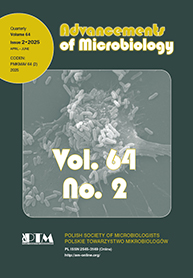ANTYGENY REKOMBINANTOWE W DIAGNOSTYCE SEROLOGICZNEJ BORELIOZY
Streszczenie: Borelioza jest najczęstszą chorobą odkleszczową dotykającą mieszkańców półkuli północnej. Chorobę tę wywołują bakterie zakwalifikowane do grupy Borrelia burgdorferi sensu lato. Współcześnie podstawą diagnostyki laboratoryjnej boreliozy jest dwustopniowe badanie serologiczne. Pierwszym etapem jest test immunoenzymatyczny (ELISA), jeżeli wynik badania jest dodatni lub wątpliwy jako test potwierdzający stosuje się technikę Western blot. W obu metodach jako główne źródło antygenów wykorzystuje się całkowite lizaty komórkowe B. burgdorferi s.l. Jednak ogromna różnorodność gatunków w obrębie B. burgdorferi s.l. oraz niski stopień zakonserwowania sekwencji ich białek sprawia, że wykorzystanie lizatów komórkowych jednego z genogatunków nie jest wystarczające do prawidłowego rozpoznania boreliozy. Liczne doniesienia literaturowe wykazują, że wykorzystanie antygenów rekombinantowych lub chimerycznych B. burgdorferi s.l. może być potencjalnym rozwiązaniem problemów występujących w immunodiagnostyce boreliozy. Jednak, aby testy diagnostyczne oparte na białkach rekombinantowych miały jak największą skuteczność należy wykorzystać w nich starannie wyselekcjonowane antygeny lub ich fragmenty. Dzięki takiemu podejściu można opracować test, którego czułość pozostanie niezależna od genogatunku B. burgdorferi s.l., który wywołał chorobę. Dodatkowo wykorzystanie jedynie fragmentów białek może zdecydowanie ograniczyć częstość występowania reakcji krzyżowych.
1. Wprowadzenie. 2. Charakterystyka wybranych antygenów B. burgdorferi s.l. 3. Diagnostyka boreliozy. 4. Problemy w serodiagnostyce boreliozy. 5. Wykorzystanie białek rekombinantowych i peptydów syntetycznych w diagnostyce boreliozy. 6. Podsumowanie
Abstract: Lyme borreliosis, an infectious disease caused by tick-borne spirochetes of the Borrelia burgdorferi sensu lato complex, is regarded as the most commonly reported vector-borne infection in the Northern Hemisphere. Currently, the basis for laboratory diagnosis of Lyme disease is a two-step serological examination. The first is an enzyme-linked immunosorbent assay (ELISA). If the test result is positive or questionable, a Western blot is used as the second phase test. In both methods, the total cell lysates of B. burgdorferi s.l. are used as the main source of antigens. However, the huge diversity of genospecies within B. burgdorferi s.l. and the low degree of preservation of the sequence of their proteins means that using the cell lysates of one of the species is not sufficient to correctly diagnose Lyme disease. Numerous literature reports show that the use of B. burgdorferi s.l. recombinant or chimeric antigens may be a potential solution to problems occurring in Lyme disease immunodiagnosis. However, for diagnostic tests based on recombinant proteins to be as effective as possible, carefully selected antigens or fragments should be used. With this approach, a test can be developed with a sensitivity that remains independent of the B. burgdorferi s.l. species which caused the disease. In addition, the exclusive use of protein fragments may definitely reduce the frequency of cross-reactions.
1. Introduction. 2. Characterization of selected B. burgdorferi s.l. antigens. 3. Diagnosis of Lyme disease. 4. Problems in Lyme disease serodiagnosis. 5. Use of recombinant antigens and synthetic peptides in the diagnosis of Lyme disease. 6. Summary

